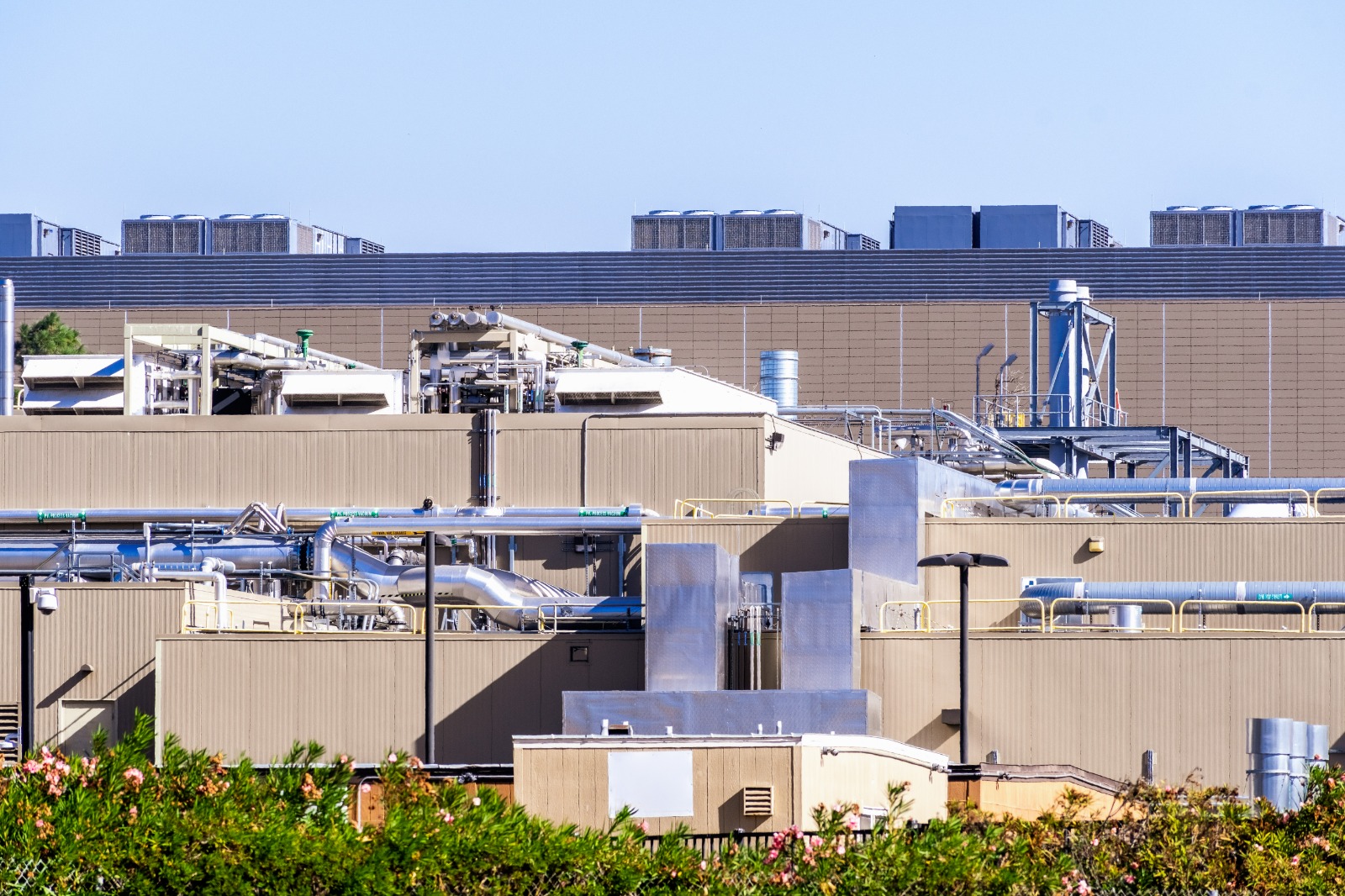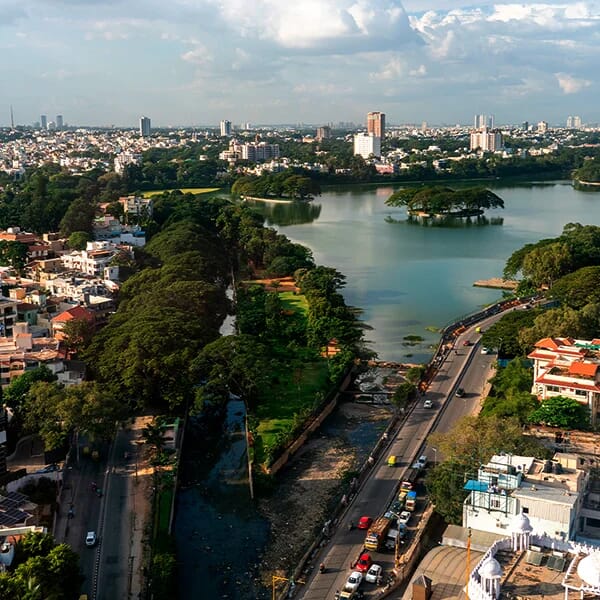
Data Centre Dominance - India on the World Stage
Insights from Kotak Alternate Asset Managers on the meteoric rise of Data Centres in India
January 25, 2024Real Estate
Written by Rory Hickman
From just 2.7 million square feet in 2017, Data Centres now occupy more than 11 million square feet in India. Meanwhile, capacity grew from 447 MW in 2021 to 819 MW in 2023 and revenue from the market is expected to reach USD 7.75 billion in 2024. With such impressive numbers it is little wonder that this asset class has created a significant stir in the country’s market, with global interest in the sector continuing to grow.
Ahead of the GRI Data Center Forum 2024, taking place in Mumbai on February 20, GRI Club spoke to three of Kotak Alternate Asset Managers’ top executives - partners Vithal Suryavanshi and Rahul Shah, and Kotak Data Centre Fund Director Ramaiy Kapoor - to get the latest details on the incredible growth being witnessed in the sector.
Founded in 2005, Kotak boasts a diverse investment portfolio with more than USD 8.5 billion in assets under management spanning real estate, infrastructure, private equity, and, more recently, data centres. Having already raised close to USD 600 million of its projected USD 800 million total, the Kotak Data Centre Fund has positioned itself as a trailblazer in the realm of digital infrastructure investment, reflecting the growing confidence in India's data centre market.
With global tech giants like Microsoft, Amazon, and Google already setting up their hyperscale data centres in India, we asked Kotak’s experts for insights into what is driving this growth and how the country has become such a powerhouse in the sector.
Rahul explains that India’s data centre market contrasts strongly with that of China, where domestic cloud players dominate, but has many parallels in the US market, emphasising the substantial investments made by US hyperscalers.
This not only reflects their confidence in India's potential but also underscores their commitment to building their own data centres in the country. Shah notes that this strategic move positions India not only as a significant market but also as a launchpad for the broader Asian region.
Highlighting the twofold impact of the global players, Ramaiy first observes a positive infusion of global best practices into India, leading to elevated standards, increased data centre sizes, and a focus on sustainability and safety.
Secondly, Kapoor notes the surge in cloud adoption in India, primarily driven by its youthful demographic. This surge catalyses increased data usage, prompting the expansion of data centres, with Kapoor foreseeing sustained foreign direct investment, benefitting developers, investors, and the government.
Focusing on India's future potential, Vithal anticipates a staggering demand of 35 gigawatts, primarily resulting from artificial intelligence. Suryavanshi sees this as a testament to the exciting growth potential in India's nascent data centre sector.
Both domestic and foreign companies, including the global giants, are contributing to the escalating demand, and with India’s GDP sitting around USD 3.5 trillion and likely to reach USD 5 trillion in the next few years (as well as a prediction of USD 15 trillion by 2035), India is poised to cement its position as a data centre hub on the global stage.
Distinguishing between international cable landing stations and the domestic broadband network, Rahul acknowledges the recent CLS capacity additions that provide India with a substantial headroom for the next decade.
Turning to the Indian broadband networks, Rahul notes that investments in various telecom equipment have resulted in consistent strengthening, leading to commendable latency indicators across multiple metro cities in the country, particularly Bombay, Mumbai, Delhi, Hyderabad, and Chennai.
While tier two cities are currently in the early stages of data centre development, both Rahul and Ramaiy anticipate forthcoming investments driven by emerging technologies such as edge networks, IoT applications, and the growing demand for AI as well as intensified enterprise adoption in these regions.
Vithal also sees the growth of data centres extending beyond tier one cities. Acknowledging India's rapid pace in digital infrastructure development, the Kotak partner emphasises private players' pivotal role in laying optic fibre connections across all cities. The aggressive expansion of the optic fibre network, he believes, will significantly impact tier two and three cities, fostering increased demand for data centres and propelling growth beyond metropolitan boundaries.
Ramaiy reassures that India's power surplus status, coupled with a significant share of green power, will seamlessly accommodate incremental data centre requirements, with states encouraging green power usage through open access power purchase agreements (PPAs).
The new regulations include a provision to establish the Data Protection Board of India, an adjudicating body to uphold and enforce the act, which is currently being set up by the government.
Drawing parallels with the regulatory landscapes in the US and Europe, Rahul emphasises the increasing need for governments worldwide to safeguard sensitive data, especially pertaining to financial transactions, defence, and governmental activities. He points out that India's proactive approach, manifested in the creation of data centre silos, ensures control and security, positioning the nation as a significant player in the global data centre market.
Rahul also noted the introduction of reciprocity in India's recent bill, highlighting the fair exchange of data storage permissions between nations. Ramaiy adds that the heightened responsibilities and liabilities on data centres from the bill, potentially mandating foreign businesses to store Indian citizens' data within the country, is anticipated to increase accountability in adhering to data storage norms, reshaping the landscape for data centre service level agreements.
Vithal accentuates the evolving legislative landscape in India, particularly focusing on the mandates for financial data to stay within the country and impending measures for social media data. The recent shift requiring financial data to remain within Indian soil is recognised as a pivotal change, with the upcoming emphasis on social media data further driving demand for data centres.
With India's massive population of 1.4 billion, compliance with these regulations is poised to propel substantial growth in the data centre industry.
The transformative role of AI, particularly generative AI, is driving the unprecedented surge in developer demand, according to Rahul. With giants like Google, Microsoft, and Amazon investing heavily in their own generative AI capabilities, the need for powerful data centres has skyrocketed.
The unique demands of AI applications, which require power-dense GPUs rather than traditional servers, pose a significant challenge. As the industry grapples with the early days of addressing these demands, the potential for data centre expansion is undeniable. However, Rahul stresses that the design specifications for these data centres catering to AI needs are significantly different, emphasising the need for innovative approaches.
Ramaiy delves into the practical applications of AI, citing its ability to predict equipment failures, optimise cooling systems, and automate routine tasks. The rise in rack density, fueled by AI adoption, prompts a crucial need for IT infrastructure upgrades. The Data Centre Fund Director envisions 2024 as a pivotal year for the redesign of data centres globally to meet the evolving demands of AI.
The impact on rack density - from 5 to 6 kilowatts to potentially 25, 30, or even 50 kilowatts - requires significant enhancements in floor loading and cooling systems. Ramaiy predicts that immersive cooling and high-density racks will be key differentiators, attracting cloud service providers to these technologically advanced data centres.
Moreover, AI's ability to reduce energy consumption by up to 30 to 40 percent aligns with the sustainability goals of organisations, contributing to a more environmentally conscious approach.
All three executives also highlight the anticipated boost from the rollout of 5G, aligning with the increasing data consumption and the proliferation of IoT-based solutions. Ramaiy predicts a significant impact on video streaming, influencing virtual reality, e-commerce, social media, and virtual marketing.
The higher floor loading and cooling requirements associated with the rising rack density are also applicable in the 5G context, further emphasising the need for data centre redesigns. The intersection of 5G and AI is expected to propel data centres into a new era, where efficiency, capacity, and sustainability take centre stage.
With their significant energy consumption, carbon emissions, generation of electronic waste, water usage, land use impact, and broader environmental and social implications, data centres present a number of challenges when it comes to sustainability and meeting ESG goals.
Vithal addresses energy concerns by pointing out India's energy surplus in most cities, ensuring readiness to meet the growing power demands of the data centre industry. In India, abundant wind and solar power resources not only address ESG concerns but also align with economic viability.
Rahul underscores the paramount importance of ESG measures, particularly in the context of power-intensive data centres, by highlighting the commitment of data centre operators, including hyperscalers, to transition towards renewable energy sources. Embracing ESG measures, the industry learns from global experiences to plan, design, develop, and manage next-generation data centres with sustainability at their core.
Beyond power consumption, Rahul emphasises the multifaceted nature of ESG, including water conservation and improvements in power efficiency through innovative designs like liquid cooling. Significant design changes are anticipated for the coming years to enhance ESG friendliness.
As integral components of regional digital frameworks, data centres are now becoming an important part of town planning, says Ramaiy, with consideration for net-zero emissions and sustainable measures. This must include alignment with environmental goals during both the setup and operation of data centres.
Ramaiy also outlines practical steps, such as the installation of electric vehicle charging stations, rooftop solar installations, and complementary measures for water conservation and air quality improvement. These initiatives not only contribute to sustainability but also cater to the increasing demand for greener building designs.
There is a need to go beyond meeting immediate demands by anticipating future needs through a proactive approach, Rahul emphasises, highlighting the significance of staying abreast of emerging technologies, noting their profound impact on data centre design, operations, and infrastructure.
Ramaiy shares his anticipation for the GRI Data Center Forum, positioning it as a pivotal intersection for data centre operators, cloud service providers, investors, and technology leaders, underscoring the importance of staying ahead of industry developments and fostering partnerships.
Vithal looks to the future with a focus on India's data centre demand, potential industry consolidations, and the influx of global demand into the Indian market. Acknowledging the buzz surrounding the Kotak fund, he emphasises the importance of the next two to three years for industry growth.
Consolidations among the existing 18 players are expected, says Vithal, adding that the survival and growth prospects of each must be evaluated. Kotak's strategy involves forming synergetic partnerships with established global players to position itself strategically in meeting the surging demand. This forward-looking approach reflects the fund's readiness to navigate the upcoming challenges and capitalise on emerging opportunities in India's dynamic data centre landscape.
Don’t miss the opportunity to stay on the cutting edge of data centre developments - register to attend GRI Data Center Forum 2024, taking place in Mumbai on February 20.

From just 2.7 million square feet in 2017, Data Centres now occupy more than 11 million square feet in India. Meanwhile, capacity grew from 447 MW in 2021 to 819 MW in 2023 and revenue from the market is expected to reach USD 7.75 billion in 2024. With such impressive numbers it is little wonder that this asset class has created a significant stir in the country’s market, with global interest in the sector continuing to grow.
Ahead of the GRI Data Center Forum 2024, taking place in Mumbai on February 20, GRI Club spoke to three of Kotak Alternate Asset Managers’ top executives - partners Vithal Suryavanshi and Rahul Shah, and Kotak Data Centre Fund Director Ramaiy Kapoor - to get the latest details on the incredible growth being witnessed in the sector.
Founded in 2005, Kotak boasts a diverse investment portfolio with more than USD 8.5 billion in assets under management spanning real estate, infrastructure, private equity, and, more recently, data centres. Having already raised close to USD 600 million of its projected USD 800 million total, the Kotak Data Centre Fund has positioned itself as a trailblazer in the realm of digital infrastructure investment, reflecting the growing confidence in India's data centre market.
Hyperscaler Horizons

(Shuo | AdobeStock)
With global tech giants like Microsoft, Amazon, and Google already setting up their hyperscale data centres in India, we asked Kotak’s experts for insights into what is driving this growth and how the country has become such a powerhouse in the sector.
Rahul explains that India’s data centre market contrasts strongly with that of China, where domestic cloud players dominate, but has many parallels in the US market, emphasising the substantial investments made by US hyperscalers.
This not only reflects their confidence in India's potential but also underscores their commitment to building their own data centres in the country. Shah notes that this strategic move positions India not only as a significant market but also as a launchpad for the broader Asian region.
Highlighting the twofold impact of the global players, Ramaiy first observes a positive infusion of global best practices into India, leading to elevated standards, increased data centre sizes, and a focus on sustainability and safety.
Secondly, Kapoor notes the surge in cloud adoption in India, primarily driven by its youthful demographic. This surge catalyses increased data usage, prompting the expansion of data centres, with Kapoor foreseeing sustained foreign direct investment, benefitting developers, investors, and the government.
Focusing on India's future potential, Vithal anticipates a staggering demand of 35 gigawatts, primarily resulting from artificial intelligence. Suryavanshi sees this as a testament to the exciting growth potential in India's nascent data centre sector.
Both domestic and foreign companies, including the global giants, are contributing to the escalating demand, and with India’s GDP sitting around USD 3.5 trillion and likely to reach USD 5 trillion in the next few years (as well as a prediction of USD 15 trillion by 2035), India is poised to cement its position as a data centre hub on the global stage.
Information Infrastructure
Having the right infrastructure is vital to the development of data centres due to their highly specialised demands. In mid-2023, the Indian government announced plans to invest an additional USD 13 billion to expand the county’s optical fibre grid, on top of the USD 8.3 billion already invested.Distinguishing between international cable landing stations and the domestic broadband network, Rahul acknowledges the recent CLS capacity additions that provide India with a substantial headroom for the next decade.
Turning to the Indian broadband networks, Rahul notes that investments in various telecom equipment have resulted in consistent strengthening, leading to commendable latency indicators across multiple metro cities in the country, particularly Bombay, Mumbai, Delhi, Hyderabad, and Chennai.
While tier two cities are currently in the early stages of data centre development, both Rahul and Ramaiy anticipate forthcoming investments driven by emerging technologies such as edge networks, IoT applications, and the growing demand for AI as well as intensified enterprise adoption in these regions.
Vithal also sees the growth of data centres extending beyond tier one cities. Acknowledging India's rapid pace in digital infrastructure development, the Kotak partner emphasises private players' pivotal role in laying optic fibre connections across all cities. The aggressive expansion of the optic fibre network, he believes, will significantly impact tier two and three cities, fostering increased demand for data centres and propelling growth beyond metropolitan boundaries.
Ramaiy reassures that India's power surplus status, coupled with a significant share of green power, will seamlessly accommodate incremental data centre requirements, with states encouraging green power usage through open access power purchase agreements (PPAs).
Bytes Beyond Borders

(SundryPhotography | Envato)
In our increasingly digital world, where vast amounts of personal and sensitive data are generated and stored, protecting this information is becoming ever more crucial. India has been consistently proactive in this area, passing the Digital Personal Data Protection Act in August of last year. The new regulations include a provision to establish the Data Protection Board of India, an adjudicating body to uphold and enforce the act, which is currently being set up by the government.
Drawing parallels with the regulatory landscapes in the US and Europe, Rahul emphasises the increasing need for governments worldwide to safeguard sensitive data, especially pertaining to financial transactions, defence, and governmental activities. He points out that India's proactive approach, manifested in the creation of data centre silos, ensures control and security, positioning the nation as a significant player in the global data centre market.
Rahul also noted the introduction of reciprocity in India's recent bill, highlighting the fair exchange of data storage permissions between nations. Ramaiy adds that the heightened responsibilities and liabilities on data centres from the bill, potentially mandating foreign businesses to store Indian citizens' data within the country, is anticipated to increase accountability in adhering to data storage norms, reshaping the landscape for data centre service level agreements.
Vithal accentuates the evolving legislative landscape in India, particularly focusing on the mandates for financial data to stay within the country and impending measures for social media data. The recent shift requiring financial data to remain within Indian soil is recognised as a pivotal change, with the upcoming emphasis on social media data further driving demand for data centres.
With India's massive population of 1.4 billion, compliance with these regulations is poised to propel substantial growth in the data centre industry.
AI Ascending
The surge in demand for AI, 5G, and edge computing is reshaping far more than just the real estate industry, but data centres are certainly on the frontlines of these new developments, with profound impacts on data centre architecture, design, and operations.The transformative role of AI, particularly generative AI, is driving the unprecedented surge in developer demand, according to Rahul. With giants like Google, Microsoft, and Amazon investing heavily in their own generative AI capabilities, the need for powerful data centres has skyrocketed.
The unique demands of AI applications, which require power-dense GPUs rather than traditional servers, pose a significant challenge. As the industry grapples with the early days of addressing these demands, the potential for data centre expansion is undeniable. However, Rahul stresses that the design specifications for these data centres catering to AI needs are significantly different, emphasising the need for innovative approaches.
Ramaiy delves into the practical applications of AI, citing its ability to predict equipment failures, optimise cooling systems, and automate routine tasks. The rise in rack density, fueled by AI adoption, prompts a crucial need for IT infrastructure upgrades. The Data Centre Fund Director envisions 2024 as a pivotal year for the redesign of data centres globally to meet the evolving demands of AI.
The impact on rack density - from 5 to 6 kilowatts to potentially 25, 30, or even 50 kilowatts - requires significant enhancements in floor loading and cooling systems. Ramaiy predicts that immersive cooling and high-density racks will be key differentiators, attracting cloud service providers to these technologically advanced data centres.
Moreover, AI's ability to reduce energy consumption by up to 30 to 40 percent aligns with the sustainability goals of organisations, contributing to a more environmentally conscious approach.
All three executives also highlight the anticipated boost from the rollout of 5G, aligning with the increasing data consumption and the proliferation of IoT-based solutions. Ramaiy predicts a significant impact on video streaming, influencing virtual reality, e-commerce, social media, and virtual marketing.
The higher floor loading and cooling requirements associated with the rising rack density are also applicable in the 5G context, further emphasising the need for data centre redesigns. The intersection of 5G and AI is expected to propel data centres into a new era, where efficiency, capacity, and sustainability take centre stage.
Sustainable Server Solutions

(Zozulinskyi | Envato)
With their significant energy consumption, carbon emissions, generation of electronic waste, water usage, land use impact, and broader environmental and social implications, data centres present a number of challenges when it comes to sustainability and meeting ESG goals.
Vithal addresses energy concerns by pointing out India's energy surplus in most cities, ensuring readiness to meet the growing power demands of the data centre industry. In India, abundant wind and solar power resources not only address ESG concerns but also align with economic viability.
Rahul underscores the paramount importance of ESG measures, particularly in the context of power-intensive data centres, by highlighting the commitment of data centre operators, including hyperscalers, to transition towards renewable energy sources. Embracing ESG measures, the industry learns from global experiences to plan, design, develop, and manage next-generation data centres with sustainability at their core.
Beyond power consumption, Rahul emphasises the multifaceted nature of ESG, including water conservation and improvements in power efficiency through innovative designs like liquid cooling. Significant design changes are anticipated for the coming years to enhance ESG friendliness.
As integral components of regional digital frameworks, data centres are now becoming an important part of town planning, says Ramaiy, with consideration for net-zero emissions and sustainable measures. This must include alignment with environmental goals during both the setup and operation of data centres.
Ramaiy also outlines practical steps, such as the installation of electric vehicle charging stations, rooftop solar installations, and complementary measures for water conservation and air quality improvement. These initiatives not only contribute to sustainability but also cater to the increasing demand for greener building designs.
Forecasting Future Frameworks
Rahul underscores the critical role hyperscalers play in shaping India's data centre landscape, meaning that having an understanding of hyperscaler needs is paramount. As the largest customers for data centres, hyperscalers' requirements not only guide current investments but also prompt forward-thinking strategies.There is a need to go beyond meeting immediate demands by anticipating future needs through a proactive approach, Rahul emphasises, highlighting the significance of staying abreast of emerging technologies, noting their profound impact on data centre design, operations, and infrastructure.
Ramaiy shares his anticipation for the GRI Data Center Forum, positioning it as a pivotal intersection for data centre operators, cloud service providers, investors, and technology leaders, underscoring the importance of staying ahead of industry developments and fostering partnerships.
Vithal looks to the future with a focus on India's data centre demand, potential industry consolidations, and the influx of global demand into the Indian market. Acknowledging the buzz surrounding the Kotak fund, he emphasises the importance of the next two to three years for industry growth.
Consolidations among the existing 18 players are expected, says Vithal, adding that the survival and growth prospects of each must be evaluated. Kotak's strategy involves forming synergetic partnerships with established global players to position itself strategically in meeting the surging demand. This forward-looking approach reflects the fund's readiness to navigate the upcoming challenges and capitalise on emerging opportunities in India's dynamic data centre landscape.
Don’t miss the opportunity to stay on the cutting edge of data centre developments - register to attend GRI Data Center Forum 2024, taking place in Mumbai on February 20.




